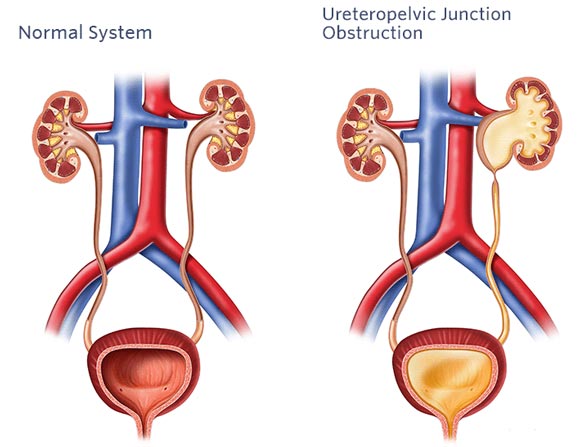Pelvi Ureteric Junction Obstruction
What is Pelviureteric Junction Obstruction?
A Pelviureteric Junction Obstruction (PUJO) blockage is a limitation in the flow of urine from the renal pelvis to the ureter that, if left untreated, may lead to gradual renal impairment.
The obstruction is usually partial, although the severity of the obstruction may range from minor to severe. Mild instances seldom impact renal function. Severe instances may decrease renal function significantly. Because it obstructs urine flow, it causes expansion of the renal pelvis (hydronephrosis).
The most prevalent cause of severe hydronephrosis seen on prenatal ultrasonography or in infants (48%) is PUJ blockage (PUJO).

What Causes Pelviureteric Junction Obstruction?
Most PUJOs are congenital (existing from birth), caused by a defect in the development of the muscle around the PUJ. PUJO may also arise later in life can be caused by a variety of reasons such as ureter compression caused by aberrant blood vessels, inflammation, stones, or scar tissue.
What are the signs and symptoms of Pelviureteric Junction Obstruction?
Most newborns (those under one year old) are asymptomatic, and most children are detected as a result of their symptoms.
Hematuria (blood in the urine), urinary tract infection (UTI), kidney stones, failure to thrive, discomfort linked with nausea and vomiting, abdominal fullness/palpable mass, or hypertension are all symptoms of PUJO.
What tests are required to confirm the diagnosis of Pelviureteric Junction Obstruction?
- Because of the increased use of prenatal ultrasonography (during pregnancy), if hydronephrosis is detected, the fetus must be examined throughout the pregnancy. A second ultrasound should be performed at least a week after the baby is delivered to confirm the PUJ obstruction
- If PUJ obstruction affects just one kidney, additional testing may be done when the newborn is 4-6 weeks old. Blood and urine tests would be performed to determine overall kidney function and rule out UTI.
- If both kidneys are affected by PUJO, your Urologist may prescribe blood and urine tests as soon as possible to determine the total kidney function. The next steps would be determined based on these results and other ultrasound information.
- A nuclear scan (DTPA/EC renogram) involves the administration of a radioactive isotope intravenously (IV), which is absorbed by the kidneys and released in urine. Images of the kidneys may be readily viewed with a specific camera. This test determines individual kidney function as well as the degree of obstruction. Above the age of four to six weeks, this test may be performed.
- CT scans are rarely required to confirm this condition and are also avoided as this involves higher radiation.
Do all PUJ obstruction cases need surgery?
The following are some common symptoms:
- The presence of symptoms related to the blockage.
- Damage to overall renal function.
- Progressive deterioration of renal function due to obstruction.
- The formation of stones, infection, or causing hypertension.
What are the potential complications if this disease is not treated?
If untreated, PUJ blockage might result in gradual renal function loss, kidney stones, or infection.
Pelviureteric Junction Obstruction Treatment
Antennally identified PUJ Obstruction is noticed if it is not severe, and a routine USG is performed to check for any rise in severity.
A renal scan is also performed to ensure that kidney function is retained while waiting. Almost 60-70 percent of these children improve during the first two years of life, and the hydronephrosis decreases. In certain cases, surgery may be necessary. Surgical indications
- Increasing hydronephrosis
- Decreasing kidney function
- Reduced kidney cortex on USG
- Pain, infections, and other symptoms Hematuria
A PUJ obstruction is often repaired (pyeloplasty) by removing the blockage and reconnecting the ureter to the renal pelvis.
Depending on the conditions, a tube may be placed across the pyeloplasty (DJ stent) or above the repair to decompress the kidney (nephrostomy).
Technique of Surgery
The basic steps of pyeloplasty as mentioned above remain the same. The initial step is to do a cystoscopy as well as a retrograde pyelogram (RGP). This is a particular x-ray scan performed under anesthesia to validate everything before surgery and to determine the precise location of the incision.
Conventional Open surgery: A small incision on the back and side of the abdomen is used to accomplish pyeloplasty.
Laparoscopic Pyeloplasty: A keyhole laparoscopic method is used to reach the blocked region. One of the most difficult restorative procedures in pediatric laparoscopy is laparoscopic pyeloplasty.
It entails dissecting the pelvi-ureteric junction, removing the joint and superfluous pelvis, and then correctly re-stitching the connection using a telescope and two small keyhole incisions on the abdomen.
Laparoscopic pyeloplasty takes somewhat longer than open surgery but is compensated for by a faster recovery and less discomfort afterward. On the abdomen, there are very few stitch marks. Laparoscopic pyeloplasty is technically challenging in infants under one year old because to the limited working area in the abdomen and lengthier anesthetic periods in newborns, but the post-op discomfort is significantly less and recovery is much faster, making it desirable to perform a pyeloplasty laparoscopically.
For more information & consultation on Pelvi Ureteric Junction Obstruction, Get in touch with Dr. Adwait Prakash a Pediatric Surgeon in Indore. will help you out in understanding your problem and guide you through every stage of your treatment.
To book your appointment Call: 8889588832.
